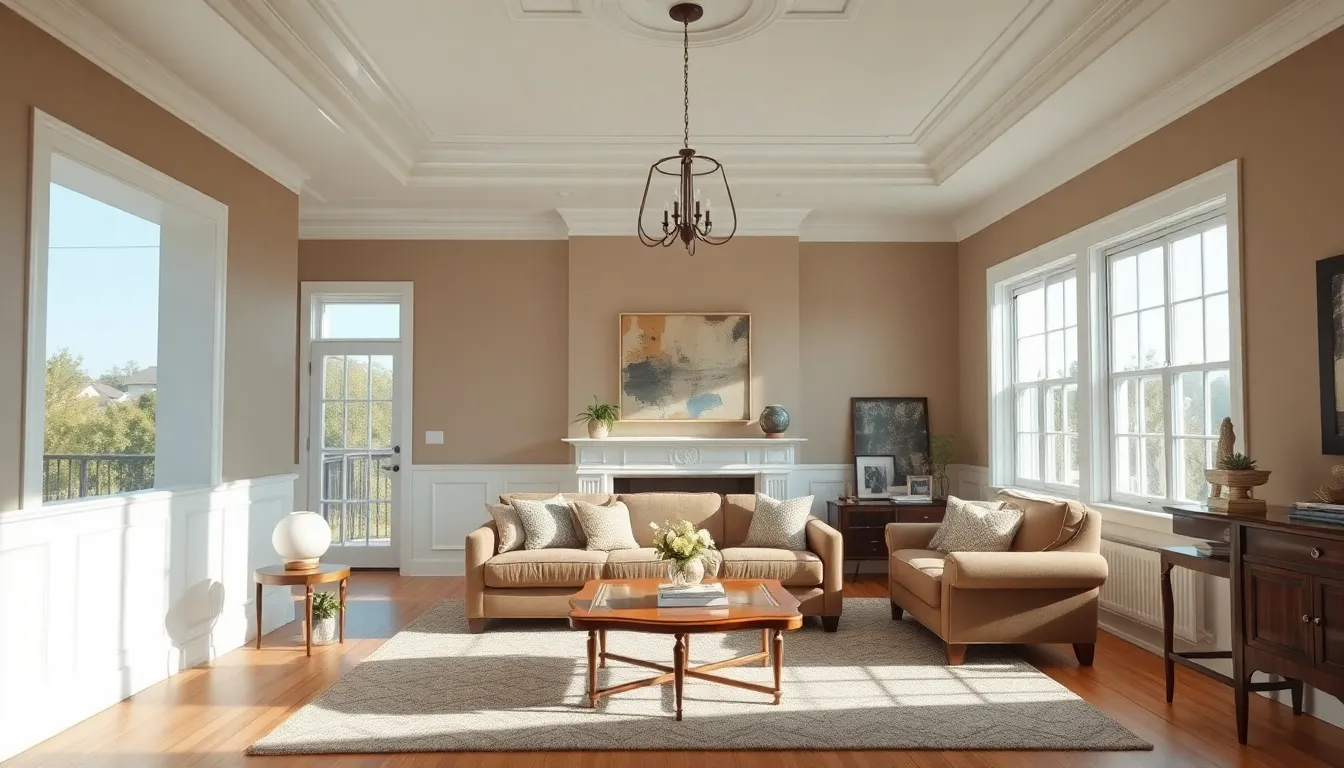When it comes to home design, trim and molding styles are the unsung heroes that can elevate a space from drab to fab faster than you can say “crown molding.” They’re like the cherry on top of a sundae—unexpected yet essential for that perfect finishing touch. Whether you’re channeling your inner Victorian aristocrat or going for sleek modern minimalism, the right trim can make all the difference.
Table of Contents
ToggleOverview of Trim and Molding Styles
Trim and molding styles encompass a variety of design options that can transform a space. Each style provides a distinct character while addressing different aesthetic needs. Crown molding, for instance, sits at the junction of walls and ceilings, creating elegance and sophistication. Baseboards, found along the bottom of walls, offer a clean finish while protecting wall edges from damage.
Wainscoting adds a touch of tradition to dining and living areas, featuring panels that elevate the overall design. Casing around doors and windows enhances architectural details, making them more prominent. The choice of material also plays a key role; wood, MDF, and polyurethane are popular choices, each with unique benefits.
Traditional trim styles, like colonial and Victorian, exude a classic charm, often featuring intricate designs. In contrast, contemporary styles maintain clean lines and simplicity, suitable for minimalist interiors. Craftsman trim boasts exposed joinery and natural wood finishes, appealing to those favoring handcrafted aesthetics.
Molding styles can also vary in profile and thickness. Thicker profiles tend to make a bolder statement, while thinner trims can create a subtler effect. Additionally, paint and stain colors can greatly influence the visual impact. Light colors can make a room feel more expansive, while darker shades add depth and warmth.
These options ensure that homeowners easily find combinations that align with their design preferences. Each style provides an opportunity to elevate the character of any room, enhancing its overall appeal. Adopting the right trim and molding style leads to a cohesive design that complements the entire home.
Common Types of Trim and Molding

Trim and molding add essential details that enhance home aesthetics. Below are common types of trim and molding.
Crown Molding
Crown molding creates a seamless transition between walls and ceilings. It typically features intricate designs that add elegance to living spaces. Styles range from simple to ornate, accommodating various architectural preferences. Homeowners often select wood or MDF for durability and visual appeal. Height also varies, affecting the room’s perceived scale. Taller ceilings may benefit from wider profiles, while smaller spaces might use thinner variations for balance.
Baseboards
Baseboards provide a clean finish at the juncture of walls and floors. They protect walls from scuff marks and give rooms a polished look. Varieties include traditional, modern, and more decorative designs, catering to diverse styles. Height options range from low-profile to more substantial styles. Materials such as hardwood, MDF, or vinyl offer flexibility in choice according to durability and aesthetic needs. Baseboard selection can significantly influence the overall atmosphere of a room.
Wainscoting
Wainscoting vertically covers lower sections of walls, adding texture and character. Its classic appeal fits well within traditional and modern designs alike. Styles include raised panels, beadboard, and flat panels, each contributing unique aesthetics. Heights can vary significantly, creating dramatic or subtle visual effects. Materials such as wood or composite options ensure longevity and ease of maintenance. Its installation can dramatically change a room’s visual depth and style.
Chair Rails
Chair rails offer ornamental trim positioned around the room’s perimeter. Originating as protection for walls from furniture damage, they now serve decorative purposes too. Heights typically range between 30 and 36 inches, enhancing visual contrast. Paint or wallpaper above and below the rail creates striking effects. Material choices include wood, PVC, or plaster, depending on desired decor compatibility. Incorporating chair rails can redefine a room’s overall style and elegance.
Material Options for Trim and Molding
Choosing the right material for trim and molding greatly affects a space’s aesthetic and durability. Various options exist, each with unique characteristics.
Wood
Wood is a classic choice for trim and molding, delivering warmth and natural beauty. Popular types include oak, pine, and poplar. These options offer durability and can be easily stained or painted to match different styles. Oak provides a strong aesthetic appeal with its rich grain, while pine offers a more budget-friendly alternative. Custom profiles can also be crafted, allowing for personalized designs that enhance architectural details. Wood’s traditional charm caters well to both modern and historical designs.
MDF
MDF, or medium-density fiberboard, presents a cost-effective alternative with numerous design benefits. Its smooth surface allows for flawless paint applications, making it ideal for various styles. Many individuals favor MDF for intricate molding designs since it can be easily shaped and customized. This material resists warping and cracking better than solid wood, providing longevity for installations. Eco-conscious consumers appreciate that MDF typically contains recycled materials, contributing to sustainability without sacrificing quality.
Polystyrene
Polystyrene stands out for its lightweight properties and easy installation. This synthetic material is moisture-resistant, making it suitable for humid environments like bathrooms or kitchens. Many homeowners choose polystyrene for its affordability and versatility in mimicry of traditional materials. It can replicate the look of wood or plaster while significantly reducing weight and cost. Custom designs in the polystyrene realm can achieve varied styles, offering practical applications for modern and classic interiors.
Tips for Choosing the Right Trim and Molding Styles
Selecting the appropriate trim and molding styles requires careful consideration. Understanding your interior design theme serves as a foundation for this decision.
Consider Your Interior Design
Identify the design style that defines your space. Traditional styles, like Colonial and Victorian, benefit from intricate moldings, while modern aesthetics thrive on clean lines and minimalism. Examine how colors and patterns interact within your room. Molding can enhance existing features or provide contrast. Match the trim’s profile and thickness to your design ethos, understanding that bold trims make statements while thinner options maintain subtlety. It’s crucial to envision how each choice complements the furniture and decor already present.
Budgeting for Materials and Installation
Assessing your budget is essential in selecting trim and molding. High-quality wood, like oak and maple, may incur higher costs. MDF offers a budget-friendly alternative, allowing for intricate designs without compromising quality. Factor in potential installation expenses, whether hiring professionals or opting for a DIY approach. Consider long-term durability when weighing costs. Moisture-resistant materials, such as polystyrene, might be more valuable in humid areas despite higher initial prices. Allocating a flexible budget will accommodate potential changes during the selection process.
Choosing the right trim and molding styles is essential for achieving a cohesive and inviting atmosphere in any home. These elements not only enhance the visual appeal but also reflect the homeowner’s personal style. By understanding the various options available and how they complement different design themes, individuals can make informed decisions that elevate their spaces.
Whether opting for the elegance of crown molding or the classic charm of wainscoting, the right trim can transform a room. It’s crucial to consider factors like materials and profiles to ensure that the final look aligns with the desired aesthetic. With thoughtful selection, trim and molding can truly be the finishing touches that bring a home to life.



